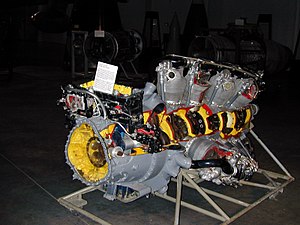Pratt & Whitney Wasp Major
| R-4360 Wasp Major | |
|---|---|
 |
|
| Pratt & Whitney R-4360 Wasp Major (sectioned) | |
| Type | Four-row Radial engine |
| National origin | United States |
| Manufacturer | Pratt & Whitney |
| First run | 1944 |
| Major applications |
Boeing 377 Boeing B-50 Superfortress Boeing C-97 Stratofreighter Convair B-36 Fairchild C-119 Flying Boxcar Hughes H-4 Hercules |
| Number built | 18,697 |
| Developed from | Pratt & Whitney R-2180-A Twin Hornet |
| Developed into | Pratt & Whitney R-2180-E Twin Wasp E |
The Pratt & Whitney R-4360 Wasp Major was a 28-cylinder four-row radial piston aircraft engine designed and built during World War II, and the largest-displacement aviation piston engine to be mass-produced in the United States. It was the last of the Pratt & Whitney Wasp family, and the culmination of its maker's piston engine technology, but the war was over before it could power airplanes into combat. It did, however, power many of the last generation of large piston-engined aircraft before the turbojet, and equivalent and superior output level turboprop powerplants like the Allison T56 took over.
The R-4360 was a 28-cylinder four-row air-cooled radial engine. Each row of seven air-cooled cylinders possessed a slight angular offset from the previous, forming a semi-helical arrangement to facilitate effective airflow cooling of the cylinder rows behind them, inspiring the engine's "corncob" nickname. A mechanical supercharger geared at 6.374:1 ratio to engine speed provided forced induction, while the propeller was geared at 0.375:1 so that the tips did not reach inefficient supersonic speeds.
Although mechanically reliable in flight, it developed an unenviable reputation for in-flight fires, particularly in its application, and in addition the Wasp Major was maintenance-intensive. Improper starting technique could foul all 56 spark plugs, requiring hours to clean or replace.
Engine displacement was 4,362.50 cu in (71.489 L), hence the model designation. Initial models developed 3,000 hp (2,240 kW), and later models 3,500 hp, but one model delivered 4,300 hp (3200 kW) using two large turbochargers in addition to the supercharger. Engines weighed 3,482 to 3,870 lb (1,579 to 1,755 kg), giving a power-to-weight ratio of 1.11 hp/lb (1.83 kW/kg).
...
Wikipedia
